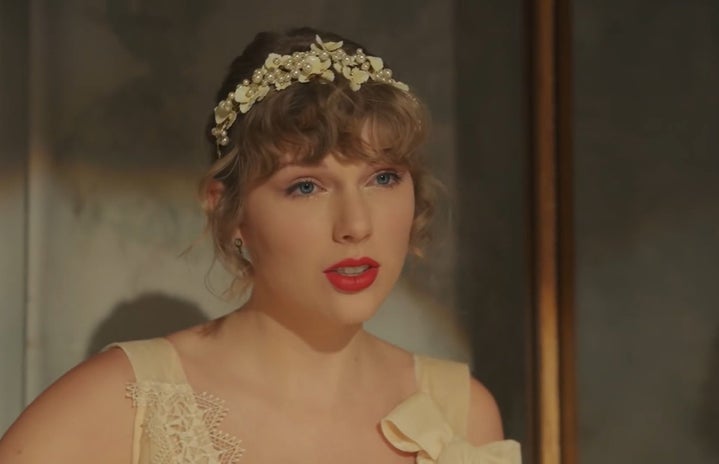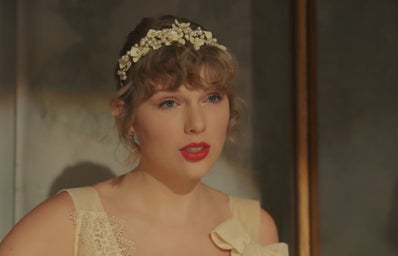The folklore and evermore albums are both masterclass examples of Taylor Swift’s iconic lyricism and musical storytelling. However, although they are considered sister albums and closely follow the same aesthetic, what’s a sisterhood without a little sibling rivalry? Many Swifties have passionate feelings about which album comes out on top as the superior installment of this era in Swift’s career. By evaluating each work for the key components of any Taylor album–lyrics, aesthetic, storyline, and bridges–I will attempt to settle the score on which album is truly the best (or should I say, the 1?).
One thing Taylor Swift is known for is her catchy and iconic lyrics which paint vivid images for the listener. In my opinion, the folklore/evermore era represents the most virtuosic and refined lyricism of her career–as the namesake suggests, the songs read very much like folk tales or poems, and when put to music, the words flow as smoothly and seamlessly as the willow branches and Windermere waters which Swift sings about. Being sister albums, the lyrical styles of evermore and folklore songs are very similar, but for me, the lyrics on evermore feel a little bit more visceral—it’s the same lyricism of folklore, but on steroids, essentially. From striking metaphors and figurative imagery in lines like “now you hang from my lips like the gardens of Babylon,” “your heart was glass I dropped it,” or “gleaming, twinkling, eyes like sinking ships on waters so inviting I almost jump in,” evermore’s dazzling poetism feels like Swift took everything that was great about folklore’s lyricism and dialed it up to 100. The lyrics became impossibly crisper and cleaner. In lines like “if you’re ever tired of being known for who you know, you know you always know me” or “I was catching my breath, staring out an open window, catching my death,” the seamless rhyme and flow is clearly evident, not just in the words themselves, but how they move with each other. While folklore has an abundance of its own incredible lyrics and figurative language, evermore simply feels like it has perfected that lyricism to an even higher degree of quality, benefitting from being the successor.
Perhaps the most iconic trademark of any Taylor Swift song, however, is the bridge. Again, I feel evermore edges folklore out ever so slightly in this category. While “cardigan” has, in my opinion, one of the greatest bridges Swift has ever written, cumulatively I would argue that evermore’s songs have incredible bridges across the board, opposed to just a couple major standouts. From the charged emotional build-ups in songs like “champagne problems,” “marjorie,” or “tis the damn season” where the words flow rapidly from Swift’s mouth with all the desperation that she sings about, it’s as if she can’t get the lyrics out fast enough. So many words and syllables are strung so deftly together all at once, crescendoing to create some of her most complex, extensive, and seamlessly flowing bridges.
In terms of aesthetic, both albums have the same folksy and cottagecore vibe. For folklore, however, this is seen more in the sound and the visuals of the album than the actual subject matter. In the promotional photos, for example, flannel shirts, fields, and pine trees abound, and the guitar plucking and phonograph sound of “the lakes” captures that nostalgic, old-timey feel. Evermore has the same woodland vibe, but it seems to delve more into the ‘folk’ aspect in its actual lyrics aside from just the album imagery, by singing about “clover blooms in the fields” or “floors of a cabin creaking under my step.” The song titles similarly reflect this, such as “willow” and “ivy.” Ironically, evermore seems to lean more into the ‘folklore’ concept than folklore itself. A majority of the songs on that album are fictional narratives or ‘folklore,’ whilst folklore feels closer to Swift and more grounded in her own personal wounds, from her tumultuous feud with music manager Scooter Braun that led to her famously rerecording her albums, to her longstanding conflict with Kanye West, and to the misogyny and sexism she has faced throughout her career. While one is not necessarily superior to the other, I would say there is a slightly more personal element in how folklore manifests that aesthetic which connects the listener more closely to Swift herself.
As for storyline, I would have to say that folklore also comes out on top as a more cohesive and structured narrative–with the Betty/James saga woven subtly throughout songs like “august,” “betty,” and maybe even “illicit affairs,” the songs feel grounded and connected to one another in a more intentional way. They also feel more thematically united in how folklore very much is a pandemic album. The songs deftly capture the state of mind that many of us were in during quarantine, from explicit allusions to essential workers in “epiphany,” to the general existential wanderings, doubts, and anxieties that were floating around in many of our heads. On folklore, this takes shape in ruminations on a love that didn’t work out ( “it would’ve been fun if you would’ve been the one” and romances that “slipped away like a bottle of wine”), the pervasiveness of lingering pain (“you knew it still hurts underneath my scars from when they pulled me apart”), insecurities that she can’t provide what her current partner needs (“would it be enough if I could never give you peace?), pent-up anger about the way the world functions (“no one likes a madwoman, you made her like that”), overall uncertainties for the future (“only 20 minutes to sleep, but you dream of some epiphany”), but all the while with the “invisible string” of love tethering Swift as she muses over these losses and fears. Whereas evermore’s storylines range from fictionalized narratives as wide-ranging as broken marriages, women killing their friends’ husbands, and wives having extramarital affairs, folklore’s more general themes about love and loss feel both more intimate to Swift and also more applicable to wider audiences. Its storyline is rooted more in the context of the times it was written in, which aids in a greater relatability, sense of nostalgia, and listener connection to the narrative.
That being said, in many ways, evermore rehashes a lot of the same themes that folklore had touched on, but with a more contemplative and mature tone, as opposed to the vindictiveness or sense of injury in folklore: this is seen starkly in “my tears ricochet” vs “happiness,” both of which are very likely about Scooter Braun. Whereas “my tears ricochet” is quite literally about an open wound (it begins by announcing a funeral), “happiness” takes a more nuanced view on the situation, reflecting that when she is “above the trees” and able to see the bigger picture, she recognizes that “there’ll be happiness after you, but there was happiness because of you, Both of these things can be true.” As is the function of many songs on evermore, it seems to make peace with the situation rather than ruminating on the things that were lost. In this way, I would say folklore is better in so far as having a more unified narrative and thematic current, but evermore largely depends on the context of folklore to enhance its meaning and impact.
This leads into the essential paradox that, at the end of the day, it seems impossible to compare the two works. Since evermore is a companion album, you really can’t have one record without the other, especially since evermore is in many ways a response to folklore. It is a completion of its arc, one that promises healing and a path forward from the doubts, anxieties, and emotional scars of folklore: “long story short I survived,” Swift writes on “closure,” and the very last line of the album is literally an assurance that “this pain wouldn’t be for evermore.” Just as Swift comes out of the drowning sea she had found herself in in the “cardigan” music video as she enters into “willow,” evermore feels like a reassurance to folklore–to that period of isolation and turmoil both in Swift’s own life but also in our society at large–that things will be okay, that recovery is on the horizon. Although in folklore Swift worried about questions of peace in the song of the same name, it seems that on evermore, she is beginning to find it. The album has a greater impact in that we as the listeners were also on that journey with her as we came out of the thick of the pandemic. So while one might be able to compare the structural components of the songs, the themes and narratives of both albums actually weave quite beautifully and inseparably together in such a way that demands they be consumed concurrently in order for their messages to be stronger.
If you would like to write for Her Campus Mount Holyoke, or if you have any questions or comments for us, please email hc.mtholyoke@hercampus.com.


